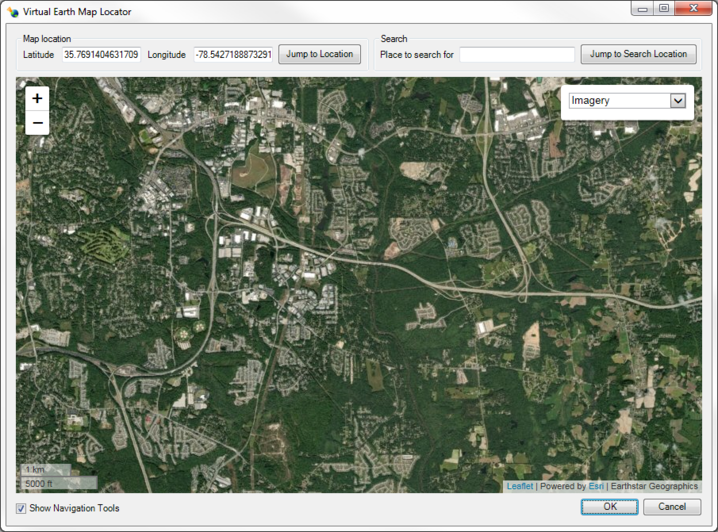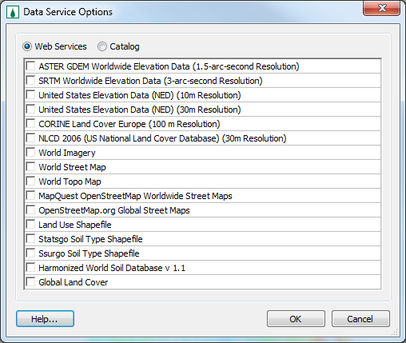Import from Web: Difference between revisions
| Line 67: | Line 67: | ||
Note that more vector-based soil and land use datasets are available; [http://www.aquaveo.com/contact-us Contact Aquaveo] if you are interested in adding data from a specific area to the list of available land use or soil data that can be downloaded. A comprehensive list of soil and land use data available for download is located [[WebServiceCatalog|here]]. | Note that more vector-based soil and land use datasets are available; [http://www.aquaveo.com/contact-us Contact Aquaveo] if you are interested in adding data from a specific area to the list of available land use or soil data that can be downloaded. A comprehensive list of soil and land use data available for download is located [[WebServiceCatalog|here]]. | ||
Terraserver images are no longer available because this web service has gone offline. | |||
== Using the Import from Web Command == | == Using the Import from Web Command == | ||
Revision as of 17:17, 6 June 2012
Overview
The Import from Web feature allows you to connect to the internet to download free data - images, elevation data etc. If you have an internet connection, this is an easy and convenient way to acquire this type of data. The data is made available for free by various entities who provide web services. Each XMS programs has a number of available data types they can retrieve.
Data Availability
Elevation (NED, ASTER, and SRTM) Data
- NED data contains the best available raster elevation data of the conterminous United States, Alaska, Hawaii, and territorial islands. NED data are not available for other areas.
- ASTER and SRTM data are available for most of the earth's surface. The ASTER dataset is reliable and high-quality.
Imagery
All the imagery (World Imagery, Street Maps, Topo Maps, and OpenStreetMap.org data) are available for anywhere on the earth. Besides downloading these images using the Import from Web command, these images can be read as online maps and then converted to a static map (stored locally on your computer) for faster display after you have decided on a project area.
Land Cover Data
- The 100 m Resolution CORINE dataset (raster) is available for anywhere in Europe.
- The 30 m NLCD dataset (raster) is only available for the conterminous United States.
- The Land Use Shapefile dataset is currently only available for the states of Utah and Louisiana.
- The Global Land Cover dataset is currently only available for Morocco.
Soil Data
- SSURGO soil datasets are available for some parts of Utah, Colorado, and California and are available for most of Louisiana.
- A STATSGO soil dataset is available for all of Utah.
- Data from the Harmonized World Soil Database are only available for Morocco.
Additional Information
Note that more vector-based soil and land use datasets are available; Contact Aquaveo if you are interested in adding data from a specific area to the list of available land use or soil data that can be downloaded. A comprehensive list of soil and land use data available for download is located here.
Terraserver images are no longer available because this web service has gone offline.
Using the Import from Web Command
This feature is found via the File|Import from Web command. This command results in the following series of dialogs.
- Warning
- If your current coordinate system is "Local", you will get the following warning dialog. The data that will be downloaded is georeferenced so your project coordinate system must be something other than 'Local'. Selecting OK will change the current coordinate system.
- Virtual Earth Map Locator
- Use the map in this dialog to go to your location of interest.
- You can zoom in or out using the controls or the mouse wheel.
- You can pan using the controls or by clicking and dragging. You can also enter the latitude and longitude to jump to a specific location.
- Use the Map Options menu to turn on the floating controls in the map (search, pan and zoom).
- Use the Map Style menu, or the floating controls, to change the map between Road, Aerial, and Hybrid.
- Data Service Options
- Here you select which type of data you are interested in.
- Save
- Now you are asked where you want to save the data. You only need to specify one file name, even if you've selected more than one type of data in the previous dialog. The files will all be given the same prefix but different suffixes.
- Confirm File Creation
- You may be asked to confirm that you want to create the files.
- Initialize Connection
- The following dialog is shown while the connection is being made.
- Select Scale
- Smaller numbers (larger scales) will result in better resolution, but longer download times.
- Downloading
- This dialog reports the download progress. If you click Abort, your image will exist but will be only that portion that you've downloaded so far.
Steps 6-8 will repeat for each data type you selected in step 4. After everything is finished, the data (images etc.) will appear in the Project Explorer.

